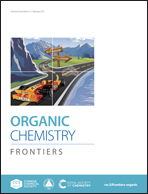State-of-the-art palladium-catalyzed alkoxycarbonylations
Abstract
Palladium-catalyzed alkoxycarbonylation reactions allow for the efficient conversion of widely available unsaturated compounds, CO and alcohols into the corresponding carboxylic acid derivatives. A driving force for the development of new and improved catalytic methodologies is the design and synthesis of ligands, which fine-tune the properties of the metal center. In general, alternation of the ligand backbone and substituents adjusts the electronic and steric properties of the active catalyst species to control activity and selectivity of a given catalytic process. Therefore, our group has a long-standing interest in ligand developments. In the past decade, several classes of ligands have been developed by us for palladium-catalyzed carbonylation reactions, which are summarized in this article. As an example, mono- and bidentate phosphines with heteroaromatic backbones were prepared to overcome the limitations of known catalyst systems. The common feature of all these ligands is the function of the integrated base, which acts as a proton shuttle for the formation of the palladium hydride and the rate-determining N-assisted alcoholysis. On the other hand, the basic substituent improves the durability of the catalyst via hemilabile coordination to the palladium center in the catalytic cycle.

- This article is part of the themed collection: 2021 Organic Chemistry Frontiers Review-type Articles


 Please wait while we load your content...
Please wait while we load your content...